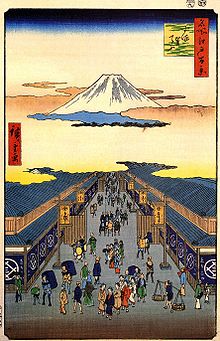- Department stores in Japan
-
Department stores in Japan are referred to as hyakkaten (百貨店) or depāto (デパート), an abbreviation of the English term.
Contents
History
The first "modern-style" department store in Japan was Mitsukoshi, founded in 1904, which has its root as a kimono store called Echigoya from 1673. When the roots are considered, however, Matsuzakaya has an even longer history, dated from 1611. The kimono store changed to a department store in 1910. In 1924, Matsuzakaya store in Ginza allowed street shoes to be worn indoors, something innovative at the time. [1] These former kimono shop department stores dominated the market in its earlier history. They sold, or rather displayed, luxurious products, which contributed to their sophisticated atmospheres. Another origin of the Japanese department store is from railway companies. There have been many private railway operators in the nation and, from the 1920s, they started to build department stores directly linked to their lines' termini. Seibu and Hankyu are the typical examples of this type.
Characteristics
Since the 1980s Japanese department stores have been facing fierce competition from supermarkets and convenience stores, gradually losing their presence. Still, depāto are bastions of several aspects of cultural conservatism in the country. Gift certificates for prestigious department stores are frequently given as formal presents in Japan.
Department stores in Japan generally offer a wide range of services and can include foreign exchange, travel reservations, ticket sales for local concerts and other events.
Due to their roots, many Japanese department stores have sections devoted to kimono and Japanese traditional crafts, including pottery and lacquerware. The basement level usually has a grocery and food court, and on the roof may be garden and aquatic supplies, pets, and a children's play area.
Operating hours are usually from 10am to 8pm. Some close one day a week, often a weekday.
Famous department stores in Japan
Some stores also have branches outside Japan.
Nationwide
- Daimaru (大丸)
- Hankyu Department Stores (阪急百貨店 Hankyū Hyakkaten)
- Isetan (伊勢丹)
- Matsuzakaya (松坂屋)
- Mitsukoshi (三越)
- Parco (パルコ Paruko) (fashion oriented, nationwide)
- Sogo & Seibu (そごう・西武)
- Loft (ロフト Rofuto) (hobby oriented, nationwide)
- Seibu Department Stores (西武百貨店 Seibu Hyakkaten)
- Sogo (そごう Sogō)
- Takashimaya (高島屋)
Hokkaidō
- Marui Imai (丸井今井)
Kantō region
- Keio Department Store (京王百貨店 Keiō Hyakkaten)
- Marui (丸井) (fashion oriented)
- Lumine (ルミネ Rumine) (fashion oriented)
- Matsuya (松屋)
- Odakyu Department Store (小田急百貨店 Odakyū Hyakkaten)
- Printemps Ginza (プランタン銀座 Purantan Ginza) (from France)
- Robinson Department Store (ロビンソン百貨店 Robinson Hyakkaten) (from Sogo & Seibu)
- Tobu Department Store (東武百貨店 Tōbu Hyakkaten)
- Tokyu Department Store (東急百貨店 Tōkyū Hyakkaten)
- 109 (Ichi-maru-kyū) (fashion oriented, Kantō region)
- Tokyu Hands (東急ハンズ Tōkyū Hanzu) (hobby oriented, nationwide)
Chūbu region
- Daiwa (大和)
- Entetsu Department Store (遠鉄百貨店 Entetsu Hyakkaten)
- Meitetsu Department Store (名鉄百貨店 Meitetsu Hyakkaten)
Kansai region
- Keihan Department Store (京阪百貨店 Keihan Hyakkaten)
- Kintetsu Department Store (近鉄百貨店 Kintetsu Hyakkaten)
- Sanyo Department Store (山陽百貨店 San'yō Hyakkaten)
- Hanshin Department Store (阪神百貨店 Hanshin Hyakkaten)
- yamatoyashiki (ヤマトヤシキ)
- Fujii Daimaru (藤井大丸 Fujii Daimaru)
Chūgoku, Shikoku region
- Tenmaya (天満屋)
- Fukuya (福屋)
- Chimakiya (ちまきや)
- Ichibata Department Store (一畑百貨店 Ichibata Hyakkaten)
Kyūshū region
- Iwataya (岩田屋)
- Izutsuya (井筒屋)
- Tokiwa (トキハ)
- Tamaya Department Store (玉屋)
- Hamaya (浜屋)
- Tsuruya Department Store (鶴屋百貨店 Tsuruya Hyakkaten)
- Yamakataya (山形屋)
- Ryubo (リウボウ Ryūbō)
Defunct in Japan
- Shirokiya (白木屋)
See also
Categories:- Department stores of Japan
- Economy of Japan
Wikimedia Foundation. 2010.


